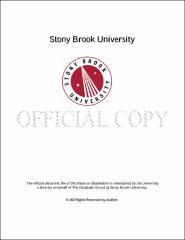| dc.identifier.uri | http://hdl.handle.net/11401/77269 | |
| dc.description.sponsorship | This work is sponsored by the Stony Brook University Graduate School in compliance with the requirements for completion of degree. | en_US |
| dc.format | Monograph | |
| dc.format.medium | Electronic Resource | en_US |
| dc.language.iso | en_US | |
| dc.publisher | The Graduate School, Stony Brook University: Stony Brook, NY. | |
| dc.type | Dissertation | |
| dcterms.abstract | A wealth of knowledge in the biomedical domain is available in unstructured or semi-structured data repositories as natural language narratives. Much of this knowledge can provide immediate and tangible benefits in patient welfare and the healthcare industry. Extracting relevant knowledge from these natural language sources and providing them as structured information suitable for immediate real-time consumption in clinical settings is, however, a manual process restricted to human domain experts. As a result, it is expensive and time-consuming. A very real consequence of this is that the journey made by medical " knowledge nuggets" from research publications to patient care settings like hospitals often take several years. Even so, the knowledge still gets presented to clinicians in natural language -- unsuitable for machine consumption, and an impediment to the pace of work often demanded of clinicians (e.g., in emergency rooms). Automatic extraction of this knowledge is a challenging task. Biomedical research literature is replete with language constructs that are highly specific to not just the domain, but internal sub-domains. The linguistic semantics used in discussions of, say, diabetes, are very different from the semantics used to discuss diseases like malaria that are caused by external agents. Moreover, being research literature, authors typically write for readers with a fair amount of encyclopaedic domain knowledge. Consequently, important information can often only be gleaned by identifying causal relations that are implicit. Standard information extraction methods that depend on identifying causality in text usually require explicit discourse connectives like " because" , " since" , etc. Additionally, they manage to extract only those relations that are expressed within the span of a single sentence. This proposal presents a novel relation learning methodology for biomedical natural language that is able to infer relations where (a) the relation is implicit, and (b) the related entities do not co-occur within the span of a single sentence. We show that our technique outperforms a sentence-level supervised classification approach. Further, as a human-in-the-loop (HITL) model, it is capable of augmenting biomedical knowledge bases quickly and accurately. Finally, we contribute two novel applications that demonstrate the use of such relational knowledge in providing real-time clinical decision support. | |
| dcterms.available | 2017-09-20T16:52:19Z | |
| dcterms.contributor | Choi, Yejin | en_US |
| dcterms.contributor | Ramakrishnan, I. V. | en_US |
| dcterms.contributor | Fodor, Paul | en_US |
| dcterms.contributor | Balasubramanian, Niranjan | en_US |
| dcterms.contributor | Davulcu, Hasan. | en_US |
| dcterms.creator | Banerjee, Ritwik | |
| dcterms.dateAccepted | 2017-09-20T16:52:19Z | |
| dcterms.dateSubmitted | 2017-09-20T16:52:19Z | |
| dcterms.description | Department of Computer Science. | en_US |
| dcterms.extent | 75 pg. | en_US |
| dcterms.format | Application/PDF | en_US |
| dcterms.format | Monograph | |
| dcterms.identifier | http://hdl.handle.net/11401/77269 | |
| dcterms.issued | 2015-12-01 | |
| dcterms.language | en_US | |
| dcterms.provenance | Made available in DSpace on 2017-09-20T16:52:19Z (GMT). No. of bitstreams: 1
Banerjee_grad.sunysb_0771E_12682.pdf: 2850908 bytes, checksum: 4d16cc26431daade772423aefd85996a (MD5)
Previous issue date: 1 | en |
| dcterms.publisher | The Graduate School, Stony Brook University: Stony Brook, NY. | |
| dcterms.subject | Computer science | |
| dcterms.subject | information extraction, natural language processing | |
| dcterms.title | Knowledge Extraction from Diverse Biomedical Corpora with Applications in Healthcare: Bridging the Translational Gap | |
| dcterms.type | Dissertation | |

